After searching high and low for your business you've finally found the perfect platform to begin offering live streams to market your services. Or you've discovered a brand-compatible YouTube channel or live streaming video blog, or maybe a well-established Facebook Live account with a bevy of followers itching at the palm to like and share your company's content.
Now how are you going to plump up your new live stream, or that outside webcam-owner’s acclaim, to get the word out about your products? Well, it’s time to start advertising.
In June the Interactive Advertising Bureau (IAB) reported that over half the number of global consumers who viewed live streamed video favor the broadcast to be ad-supported and free of charge, rather than pay to watch the video. Which opens up numerous opportunities to promote your business.
So if you’re ready to insert an ad or two into your live stream, or back somebody else's video with your advertisements, you’re undoubtedly wondering how to effectively plug paid sponsorship. Fret not - here are a few of the best ways to do it.

1. Mid-Roll Ads: And Now, A Word From Our Sponsors
This one’s the simplest: Insert an ad break. We’ve been doing it for hundreds of years. In live streaming terms this is more commonly referred to as a mid-roll ad break, and this type of advertisement is great for breaking up longer video content.
Pros: Generally speaking, an ad break is also a content break for the performer. Companies who want a commercial interruption will usually provide a commercial. They hit the switch and kick back. That’s a thirty-second paid vacation they’ll be happy to take. Encourage them to use this time to travel. Like, to the kitchen or something.
Cons: Unless you’re the Super Bowl, your audience has already been programmed by years of television to tune right out when the commercials come on.
2. Companion Ads
A companion ad is something you’ve definitely seen but might not know the name of. It’s that ultra wide-frame advertisement that pops up at the bottom of the video you’re watching.
Pros: Simple, easy, and almost impossible to mess up. It’s a tiny box at the bottom of the screen. Buy the space and forget that it’s there.
Cons: Distracting as all get out, here are some of the ads most likely to get skipped. Sometimes being eye catching just makes it easier for people to find that little “x” in the corner.

3. Homepage Takeovers
For the fancy shmancy entrepreneur, might we suggest something in a full website takeover? It’s an option: for a (usually pretty big) fee, companies can purchase space on the front pages of websites like Twitch and YouTube Live.
Pros: Highly visible. Hard to ignore. Makes a statement right up front.
Cons: Hoo doggy, does it get expensive. Not available on all platforms.
4. Product Placement
Product placement is a time-honored technique that helped convince everyone in the mid-'00s that the Motorola Razr was the last word in technology. It’s a dice roll when it comes to whether or not the artist pitching a product is actually down with what they're selling. Generally they’re pretty stoked, however, to see how casually mentioning something like the cool, refreshing taste of Pineapple Fanta can help their own bottom line.
Pros: It’s easy. It’s instant. The use of a local celebrity will quickly generate interest in your product. And everybody loves getting free Pineapple Fanta out of a deal.
Cons: It’s like throwing clay pigeons at snarky commenters, and it has been for decades. See: Wayne’s World, The Truman Show, and pretty much every review of Man of Steel.
And those are just the basics. One of the greatest things about the internet is how it reminds you just about everything has already been tried somewhere already. Which makes it a great idea to check out a few sponsored live streams for yourself. See what works and what doesn’t, and identify what sort of advertising will work best for your brand.




.png)
.png)
.png)






